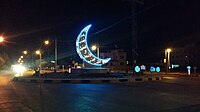Chaand Raat
| Chaand Raat | |
|---|---|
 A crescent moon marking the beginning of the Eid al-Fitr in 2020 | |
| Observed by | Muslims |
| Type | Islamic |
| Related to | Ramadan, Eid al-Fitr, Eid al-Adha |
Chaand Raat (Bengali: চাঁদ রাত, Hindi: चाँद रात, Urdu: چاند رات, lit. 'Night of the moon') is a South Asia locution, used for the eve of the Muslim festival of Eid ul-Fitr; it can also mean a night with a new moon for the new Islamic month Shawwal. Chaand Raat is a time of celebration when families and friends gather in open areas at the end of the last day of Ramadan to spot the new moon, which signals the arrival of the Islamic month of Shawwal and the day of Eid. Once the moon is sighted, people wish each other Chaand Raat Mubarak ("Have a blessed night of the new moon") or Eid Mubarak ("Blessings of the Eid day"). Women and girls decorate their hands with mehndi (henna), and people prepare desserts for the next day of Eid and do last rounds of shopping.[1] City streets have a festive look, and brightly decorated malls and markets remain open late into the night.[2][3] Chaand Raat is celebrated festively and passionately by Muslims (and occasionally non-Muslims as well) all over South Asia, and in socio-cultural significance, is comparable to Christmas Eve.
Etymology[]

The term is derived from the Hindustani chānd rāt (Devanagari: चाँद रात, Nastaʼlīq: چاند رات), literally translating to 'moon night'. The two words in the term are derived from the Sanskrit words candrá (चंद्र) "moon"[4] and rā́tri (रात्रि) "night",[5] respectively.
Background[]
Chaand Raat celebrations occur on the eve of Eid ul-Fitr, which is celebrated on 1 Shawwal. The beginning of an Islamic month depends on the first sighting of the lunar crescent and thus the month of Ramadan can be of either 29 or 30 days. Chaand Raat occurs on the same evening on which first lunar crescent of the month of Shawwal is observed. As the exact day of Eid ul-Fitr is dependent on the moon sighting, Chaand Raat is often considered more festive on Eid ul-Fitr than Eid ul-Adha, which is known well in advance.
Festivities[]
Once the new moon is sighted, announcements are made from mosques, television channels and radio stations. Festivities begin almost instantly and continue all night until the morning Fajr prayer. Entire families head out towards the local bazaars, markets and shopping malls. Women usually purchase items such as shalwar kameez, bangles, jewelry, and bags while men mostly concentrate on shoes. Gifts and sweets are brought for friends while toys are brought for children. Barber shops and beauty parlors are also heavily visited in the evening in preparation for the following day. Women and girls decorate their hands with mehndi as well.People decorate their house and pre papered eid food. Decorative lights are put up in markets as well as government buildings, banks and mosques. Chaand Raat also gives a chance for people to meet with friends and extended family. Takbeer and Islamic music also held on public.[6]
Nowdays Chandraat parties are pretty common in urban areas. Same colored Pajama often wear. Movie night or game night with henna decoration are happen.
See also[]
- Festivals in Pakistan
- Ruet-e-Hilal Committee
References[]
- ^ Jamila Achakzai. "'Chand Raat' is here again". The News. Retrieved 25 June 2017.
- ^ Adeela Akmal. "12 Things That Only Pakistanis Do on Chand Raat". Web Chutney. Archived from the original on 13 June 2018. Retrieved 25 June 2017.
- ^ "City gears for Chand Raat". The Times of India. 5 December 2002. Retrieved 1 August 2009.
- ^ "चन्द्र, candra, moon". Spoken Sanskrit Dictionary. Retrieved 1 August 2009.
- ^ "रात्रि, raatri, night". Spoken Sanskrit Dictionary. Retrieved 1 August 2009.
- ^ S.K. Pakistan. "13 Times Pakistanis Go Wild on Every Chaand Raat". Shugal.com. Archived from the original on 24 November 2018. Retrieved 25 June 2017.
External links[]
- Fasting in Islam
- Festivals of Bangladeshi culture
- Festivals in India
- Festivals in Pakistan
- Eid (Islam)
- Ramadan
- Islamic terminology
